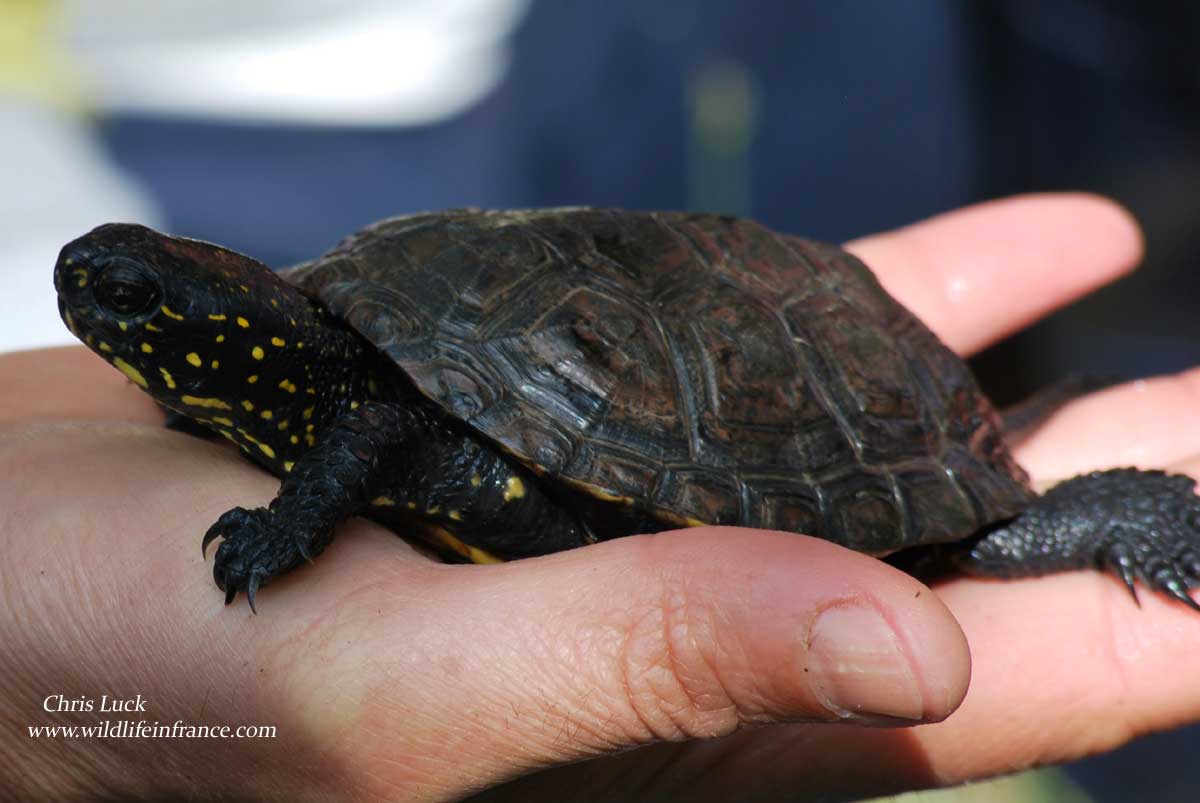European Pond Turtle
Emys orbicularis
Cistude d’Europe
The Cistude d’europe is one of the two native freshwater turtle present in France, the other being l’Emyde Lépreuse Mauremys leprosa, which is only found in parts of Languedoc-Roussillon, Pyrénées-Orientales and Aquitaine. There is a third freshwater turtle la Tortue à tempes rouges or the Florida Turtle Trachemys scripta elegans .which can be found in almost every region, these have been introduced and are not native species.
The European Pond Turtle is about 20cm long when fully grown with a smooth domed shell, brownish grey in colour with yellow dots and dashes,. They can be found in both small and large lakes, canals and rivers of all types with a preference for plenty of surface and submerged vegetation with reed banks. Here they can source their food which is predominately insects and small water creatures although on occasion they will eat small sick or dead fish and small rodents etc. that fall and drown in the water
Reproduction for Cistudes as with other amphibious creatures can be a dangerous affair, the male during courtship can inflict serious injuries on the female with his sharp claws but without these he would never maintain a grip during coupling; the female also has to be sure to get onto a firm surface at the waterside to avoid being drowned, even more so if a second male decides to get involved. Having survived this risky affair which generally takes place in April or May a short period of time elapses, then in June or July the female climbs out of the water and searches for a piece of land that will not flood where she lays between 3 and 13 eggs, normally 8 or 9 in a small hole in soft soil. The young break out together and find their way to the water after a period of incubation of about 3 months, if the births are too late in the year the young may remain in hibernation where they were born. Hibernation normally takes place from October to March often in banks of rushes. Sexual maturity is reached between 8 and 15 years in the case of males, 10 to 15 years for females and they have a natural life span of 40 to 60 years, 100 years or more being possible.
They are a species that likes to be left in peace and quiet being generally fearful and always alert for any threat. They will commonly move around in an area of about 40 to 80 square metres a day and in some cases will leave the water they are in to move to another stretch of water nearby. In the case of females this will only be a few hundred metres, for males this distance can be more than a kilometre.
The population has declined substantially due in the main part to degradation and loss of habitat, although there are some other factors. Principally the loss of habitat is the result of anthropisation, land drainage, algae blooms encouraged by agricultural fertilisers, reduction of aquatic vegetation by mechanical or chemical means and removal of reed beds and margins, this in part caused by ragondins ( coypu – another introduced species ). Other factors include their destruction by anglers, predation of their eggs by stone martens, foxes, boar, etc. Accidental drowning in passive fishing nets, females being killed by mowing at egg laying time, competition from the Florida turtle and theft for or by people who wish to have one or more at home.
A lot of action is already being taken and the recent rules on the barrier margin between rivers and cultivation should assist in reducing pollution and giving protection for egg laying. Conserving the aquatic vegetation and in selected areas limiting the populations of Coypu and Muskrat (rats musqués) Ondatra zibethicus, erecting grill fencing for egg protection and forbidding the use of certain types of traps and nets. Continuous surveillance and more study are of the utmost importance. There are also a number of reintroduction projects, including captive breeding, in various places in France.
Three Pond turtle eggs that failed to develop, possibly not fertilised, four others hatched and were fine. La Brenne, France.
Monitoring the position and movements of Pond Turtles in France.
Fully protected species







